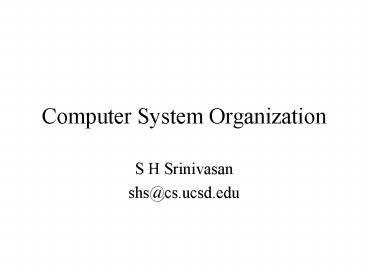Computer System Organization - PowerPoint PPT Presentation
Title:
Computer System Organization
Description:
Clock speed. Bandwidth: memory, device. What does the OS ... We can execute the program one instruction at a time, keeping only one instruction in memory. ... – PowerPoint PPT presentation
Number of Views:32
Avg rating:3.0/5.0
Title: Computer System Organization
1
Computer System Organization
- S H Srinivasan
- shs_at_cs.ucsd.edu
2
von Neumann Architecture
- CPU
- arithmetic logical unit
- control unit
- Memory
- I/O
- Bus
3
von Neumann Architecture
CPU
Control Unit
ALU
Address bus
Data bus
Memory
Device controller
4
Control Unit
- Operation
- fetch
- decode
- execute
- Registers
- PC (program counter)
- IR (instruction register)
- PS (processor status)
- SP (stack pointer)
5
Control unit operation
PC ltmachine start addressgt IR
memoryPC haltFlag FALSE while (!haltFlag)
execute(IR) PC PC
sizeof(INSTRUCTION) IR memoryPC
6
Memory
- MAR
- MDR
- command Read/Write
7
ALU
- General purpose registers
- Functional units addition, multiplication, etc.
- Status flags carry, overflow, etc.
8
Devices
- Control register
- accepts commands
- Status register ready, busy
- polling
- Data registers
- I/O character, block
9
I/O operation
while (device.busy device.done) device.data0
ltvalue to writegt device.command
WRITE while(device.busy) device.done TRUE
The above illustrates busy-wait operation This
can be speed up using interrupts
DMA
10
Interrupts
- Asynchronous input to CPU
- Processor state (PC) needs to be saved
- where? Stack
- one more register SP
- Priorities each interrupt has a priority
- Masking
- IPL interrupt priority level
- if (input IPL lt current IPL) ignore the interrupt
11
Interrupt processing
/ assuming the interrupt is not masked / (1)
push PC and PS on the stack (2) set current IPL
input IPL (3) handle interrupt / jump to
service routine / (4) restore the IPL (5)
restore the PC and PS (from the stack)
12
DMA
- Device ltgt Memory data transfer is usually
through the CPU - read device, write memory or read memory, write
device - Huge data transfer between memory and device lot
of overhead - DMA Direct device ltgt memory data transfer
without CPU intervention
13
Bootstrapping
- Power-up CPU starts executing from a fixed
location - This program reads a fixed number of bytes from a
fixed location in disk (boot sector) - The program in the boot sector is called the
bootstrap loader - The bootstrap loader loads the OS
14
Hardware support
- Processor modes
- Special instructions
- traps
- Atomic operations
- test and set
- Exceptions
15
Processor Modes
- Two modes supervisor and user
- Supervisor
- all instructions can be executed, e.g., halt
- all memory can be accessed
- User
- subset of instructions and memory
16
Traps
- trap is a software instruction with a single
parameter - example, trap 40
- can be executed in the user mode
- when executed, changes the mode to supervisor and
calls a subroutine associated with the number
(40)
17
Traps (contd)
- These subroutines are written by the OS developer
and not the user - system calls are basically C language wrappers
for traps
18
Exceptions
- Exceptions signal error conditions
- illegal memory access
- divide by zero
- Exceptions are equivalent to traps except that
they are invoked by the hardware
19
- traps, exceptions synchronous
- caused by the current instruction
- interrupts asynchronous
- caused by external events like user typing
- traps invoked by user
- exceptions invoked by hardware because of error
20
System parameters
- Data, Address size
- Clock speed
- Bandwidth memory, device
21
What does the OS provide?
- Multiple processors
- Unlimited memory
- Easy I/O
- How?
22
What does a program really want?
- Current instruction (locality)
- Register values PC, SP, SR, other registers
- Nothing else!
- We can execute the program one instruction at a
time, keeping only one instruction in memory.
23
What does the kernel do?(Highly simplified)
- Take one program
- restore the register values
- execute one instruction
- save the register values
- Take another program
- repeat the same operation
- In practice, kernel executes the program for one
time slice and keeps several pages in memory. - Kernel needs some machinery to do this
24
Timer
- Timer is absolutely essential for time slice
allocation, error detection (timeout), etc. - Most systems also have a realtime clock
- timer vs. cpu clock vs. wall clock
25
Programming abstraction for processes
if ((pid fork()) 0) / child code
/ / begins independent execution
/ else / error / / rest of
parent code / / if there is no error, there
are two processes here /































